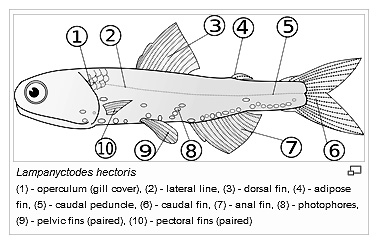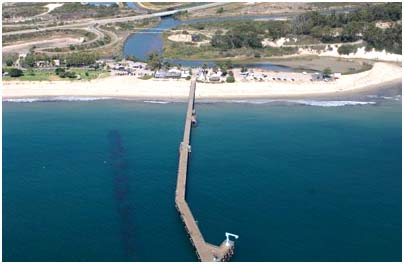 Fish
identification relies heavily on knowing the proper terms for the various
body parts of the fish.
Fish
identification relies heavily on knowing the proper terms for the various
body parts of the fish.
Other information you will find useful to note is the fish's length
and girth, skin color and texture (smooth, scaly), and its overall shape
(flat, oval, round etc.).
Where you caught the fish (habitat) can provide important clues as well
as the type of bait and time of day.
Search
by Fish Image: This is the primary search tool
since 'one picture is worth a thousand words'. It consists of multiple
images grouped in four sections
(plates). Once you have made a tentative identification click on
the image to review additional identifying characteristics and to
learn more about its natural history including bait preferences and other
important fishing information.
Search by Fish Group:
If
you haven't found your fish in the image link above then check the links
below to see what 'group' the fish in in. It is possible your fish
is not one which is commonly caught. Knowing the 'group' allows you to
do a Google Image search
for more examples.
Croakers
|
Flatfish
| Rays | Rockfish
| Sea Bass | Sharks
| Surfperch | Tunas
& Mackerels | Other
Search by Fish Habitat:
Commonly
caught sport fishes grouped by habitat types. Knowing what
species are more likely to be present where you are fishing allows you
to choose the most appropriate baits and angling styles. Goleta has species
from each of the habitats below.
Shallow
Sandy | Shallow
Rocky | Deep
Sandy |
Deep Rocky | Pelagic
| Surf
| Bay
Search
by Common or Scientific Name: It is always
helpful to know the correct scientific name for each species and this list
allows you to cross reference from the common name to the scientific name.
Using the scientific name in a Google search will help narrow your search
considerably.
Credits:
The above links are to the California Department of Fish & Game's excellent
online publication, Marine
Sportfish Identification.
Goleta's
Kelp Reef: In addition
to the resources above here are pictures and illustrations of 45 different
species of fish caught while surveying the pipeline reef community which
has established itself approximately 30 yards west of the pier. 
This study was conducted during the 2002-2003 season in order to document
the status of the existing fish stocks prior to the initiation of seasonal
rockfish closures the following year.
The data is also displayed in a statistical spreadsheet format with
monthly and annual totals of species and individual fish caught.
The 114 daily fishing logs from that survey are included
as well.
Still in doubt ... email
me with as much information as you have (pictures if possible) about
your catch and I will submit it to the DFG for an authoritative identification.
Good Luck and remember - if you haven't identified
your catch you should not be keeping it ... it might not be legal.
Fish responsibly.
Thank You.
Questions or comments? ... email Pierhead
Copyright © 2007 by Boyd Grant. All Rights Reserved